Impact of Fake News on Society
VerifiedAdded on 2022/11/24
|8
|1927
|202
AI Summary
This article discusses the impact of fake news on society, including how it can lead to confusion, racism, and the destruction of reputations. It explores the challenges in combating fake news and the need for strong norms in professional journalism and literacy education. The article also examines the existing laws in Malaysia, such as the Communications and Multimedia Act and the Printing Presses and Publications Act, and suggests ways to address fake news through legislation and incentives.
Contribute Materials
Your contribution can guide someone’s learning journey. Share your
documents today.
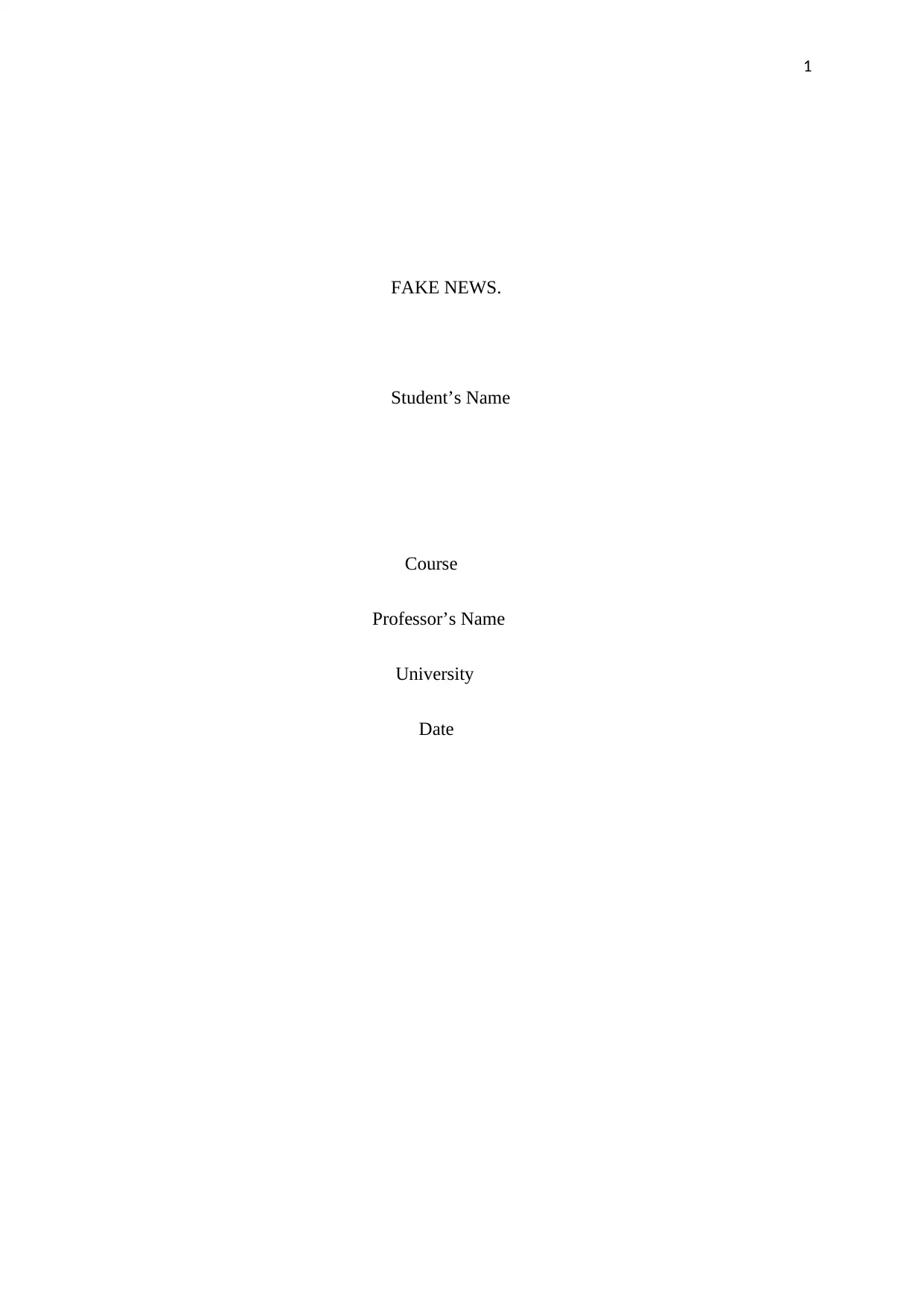
1
FAKE NEWS.
Student’s Name
Course
Professor’s Name
University
Date
FAKE NEWS.
Student’s Name
Course
Professor’s Name
University
Date
Secure Best Marks with AI Grader
Need help grading? Try our AI Grader for instant feedback on your assignments.
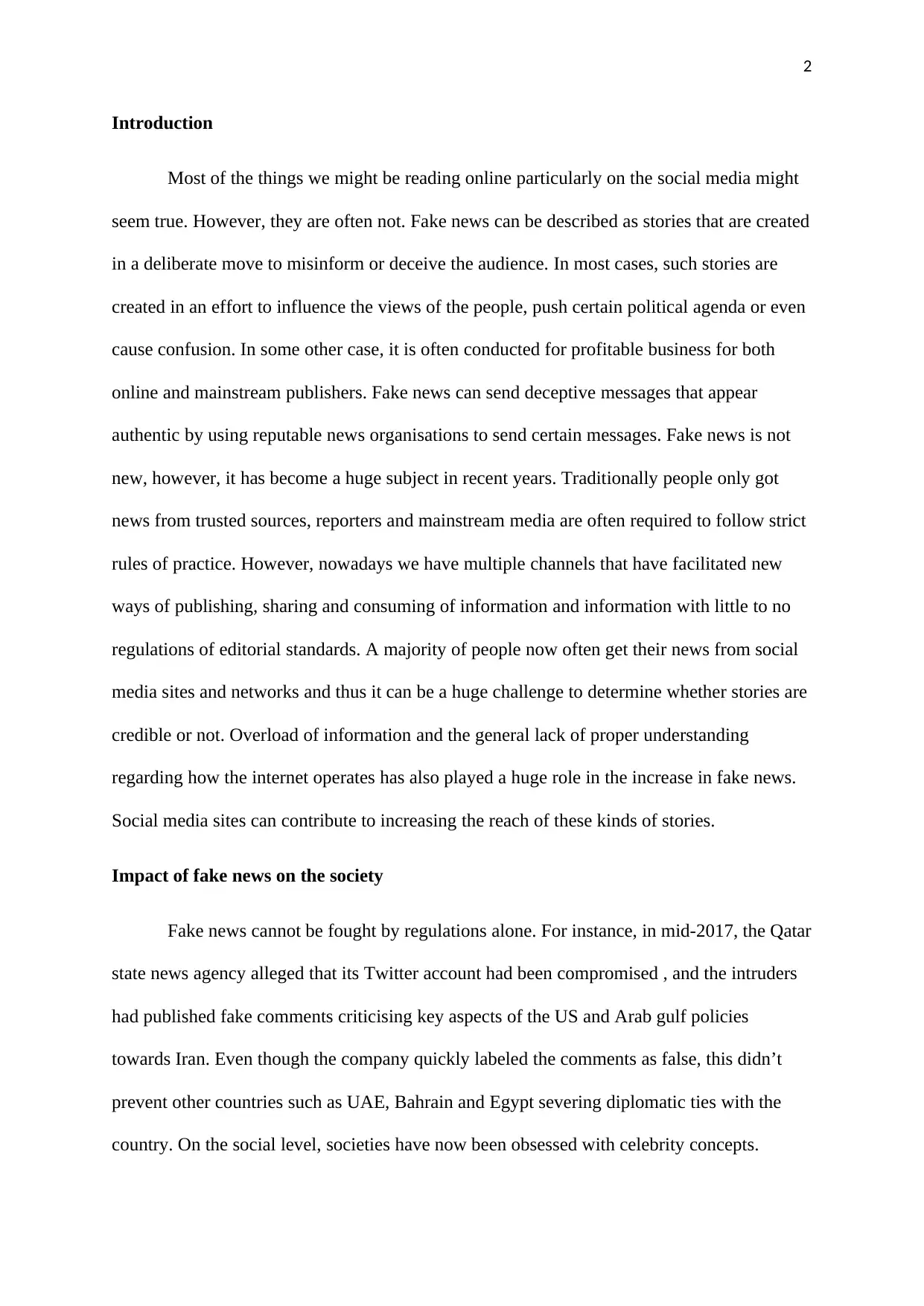
2
Introduction
Most of the things we might be reading online particularly on the social media might
seem true. However, they are often not. Fake news can be described as stories that are created
in a deliberate move to misinform or deceive the audience. In most cases, such stories are
created in an effort to influence the views of the people, push certain political agenda or even
cause confusion. In some other case, it is often conducted for profitable business for both
online and mainstream publishers. Fake news can send deceptive messages that appear
authentic by using reputable news organisations to send certain messages. Fake news is not
new, however, it has become a huge subject in recent years. Traditionally people only got
news from trusted sources, reporters and mainstream media are often required to follow strict
rules of practice. However, nowadays we have multiple channels that have facilitated new
ways of publishing, sharing and consuming of information and information with little to no
regulations of editorial standards. A majority of people now often get their news from social
media sites and networks and thus it can be a huge challenge to determine whether stories are
credible or not. Overload of information and the general lack of proper understanding
regarding how the internet operates has also played a huge role in the increase in fake news.
Social media sites can contribute to increasing the reach of these kinds of stories.
Impact of fake news on the society
Fake news cannot be fought by regulations alone. For instance, in mid-2017, the Qatar
state news agency alleged that its Twitter account had been compromised , and the intruders
had published fake comments criticising key aspects of the US and Arab gulf policies
towards Iran. Even though the company quickly labeled the comments as false, this didn’t
prevent other countries such as UAE, Bahrain and Egypt severing diplomatic ties with the
country. On the social level, societies have now been obsessed with celebrity concepts.
Introduction
Most of the things we might be reading online particularly on the social media might
seem true. However, they are often not. Fake news can be described as stories that are created
in a deliberate move to misinform or deceive the audience. In most cases, such stories are
created in an effort to influence the views of the people, push certain political agenda or even
cause confusion. In some other case, it is often conducted for profitable business for both
online and mainstream publishers. Fake news can send deceptive messages that appear
authentic by using reputable news organisations to send certain messages. Fake news is not
new, however, it has become a huge subject in recent years. Traditionally people only got
news from trusted sources, reporters and mainstream media are often required to follow strict
rules of practice. However, nowadays we have multiple channels that have facilitated new
ways of publishing, sharing and consuming of information and information with little to no
regulations of editorial standards. A majority of people now often get their news from social
media sites and networks and thus it can be a huge challenge to determine whether stories are
credible or not. Overload of information and the general lack of proper understanding
regarding how the internet operates has also played a huge role in the increase in fake news.
Social media sites can contribute to increasing the reach of these kinds of stories.
Impact of fake news on the society
Fake news cannot be fought by regulations alone. For instance, in mid-2017, the Qatar
state news agency alleged that its Twitter account had been compromised , and the intruders
had published fake comments criticising key aspects of the US and Arab gulf policies
towards Iran. Even though the company quickly labeled the comments as false, this didn’t
prevent other countries such as UAE, Bahrain and Egypt severing diplomatic ties with the
country. On the social level, societies have now been obsessed with celebrity concepts.
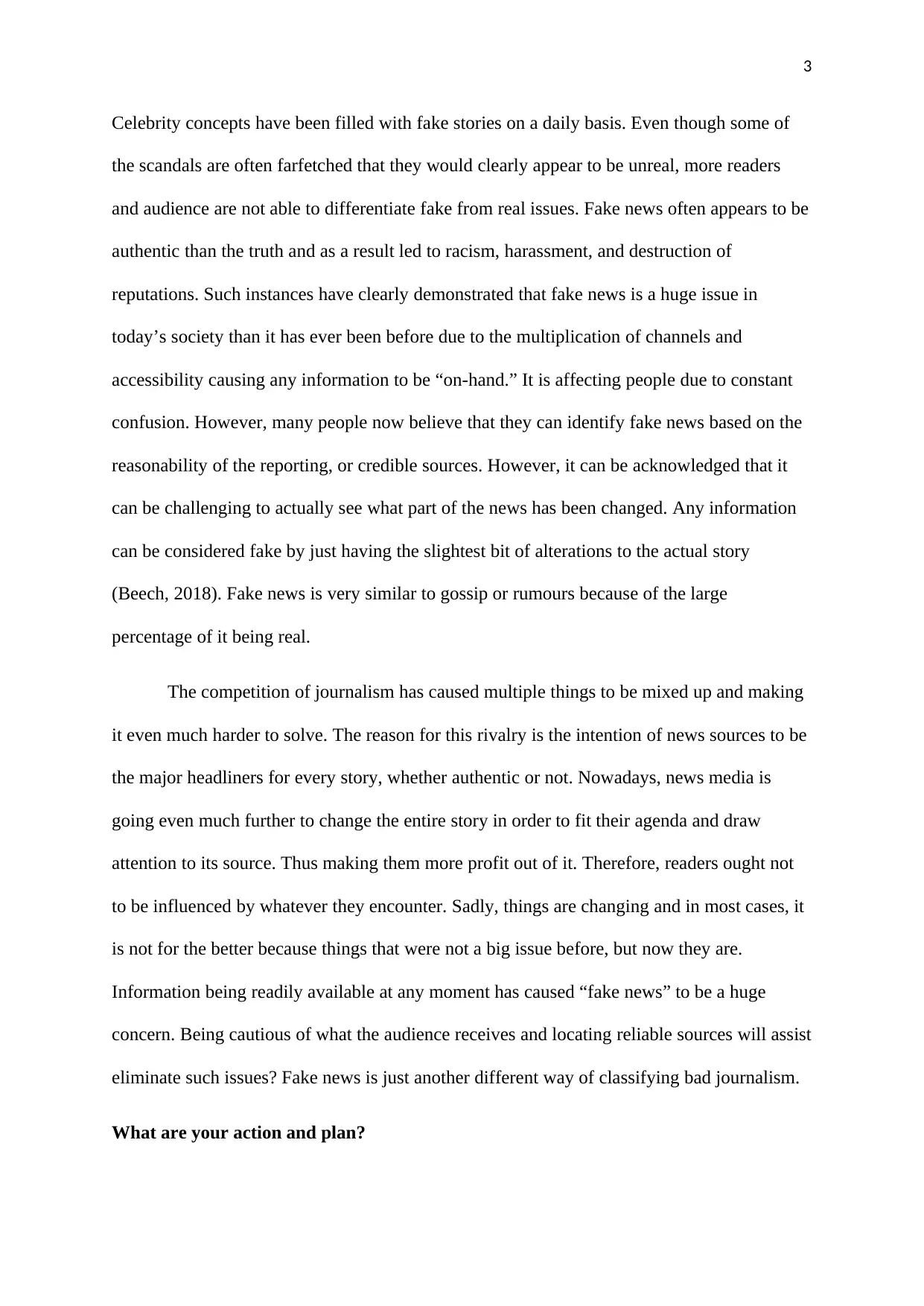
3
Celebrity concepts have been filled with fake stories on a daily basis. Even though some of
the scandals are often farfetched that they would clearly appear to be unreal, more readers
and audience are not able to differentiate fake from real issues. Fake news often appears to be
authentic than the truth and as a result led to racism, harassment, and destruction of
reputations. Such instances have clearly demonstrated that fake news is a huge issue in
today’s society than it has ever been before due to the multiplication of channels and
accessibility causing any information to be “on-hand.” It is affecting people due to constant
confusion. However, many people now believe that they can identify fake news based on the
reasonability of the reporting, or credible sources. However, it can be acknowledged that it
can be challenging to actually see what part of the news has been changed. Any information
can be considered fake by just having the slightest bit of alterations to the actual story
(Beech, 2018). Fake news is very similar to gossip or rumours because of the large
percentage of it being real.
The competition of journalism has caused multiple things to be mixed up and making
it even much harder to solve. The reason for this rivalry is the intention of news sources to be
the major headliners for every story, whether authentic or not. Nowadays, news media is
going even much further to change the entire story in order to fit their agenda and draw
attention to its source. Thus making them more profit out of it. Therefore, readers ought not
to be influenced by whatever they encounter. Sadly, things are changing and in most cases, it
is not for the better because things that were not a big issue before, but now they are.
Information being readily available at any moment has caused “fake news” to be a huge
concern. Being cautious of what the audience receives and locating reliable sources will assist
eliminate such issues? Fake news is just another different way of classifying bad journalism.
What are your action and plan?
Celebrity concepts have been filled with fake stories on a daily basis. Even though some of
the scandals are often farfetched that they would clearly appear to be unreal, more readers
and audience are not able to differentiate fake from real issues. Fake news often appears to be
authentic than the truth and as a result led to racism, harassment, and destruction of
reputations. Such instances have clearly demonstrated that fake news is a huge issue in
today’s society than it has ever been before due to the multiplication of channels and
accessibility causing any information to be “on-hand.” It is affecting people due to constant
confusion. However, many people now believe that they can identify fake news based on the
reasonability of the reporting, or credible sources. However, it can be acknowledged that it
can be challenging to actually see what part of the news has been changed. Any information
can be considered fake by just having the slightest bit of alterations to the actual story
(Beech, 2018). Fake news is very similar to gossip or rumours because of the large
percentage of it being real.
The competition of journalism has caused multiple things to be mixed up and making
it even much harder to solve. The reason for this rivalry is the intention of news sources to be
the major headliners for every story, whether authentic or not. Nowadays, news media is
going even much further to change the entire story in order to fit their agenda and draw
attention to its source. Thus making them more profit out of it. Therefore, readers ought not
to be influenced by whatever they encounter. Sadly, things are changing and in most cases, it
is not for the better because things that were not a big issue before, but now they are.
Information being readily available at any moment has caused “fake news” to be a huge
concern. Being cautious of what the audience receives and locating reliable sources will assist
eliminate such issues? Fake news is just another different way of classifying bad journalism.
What are your action and plan?
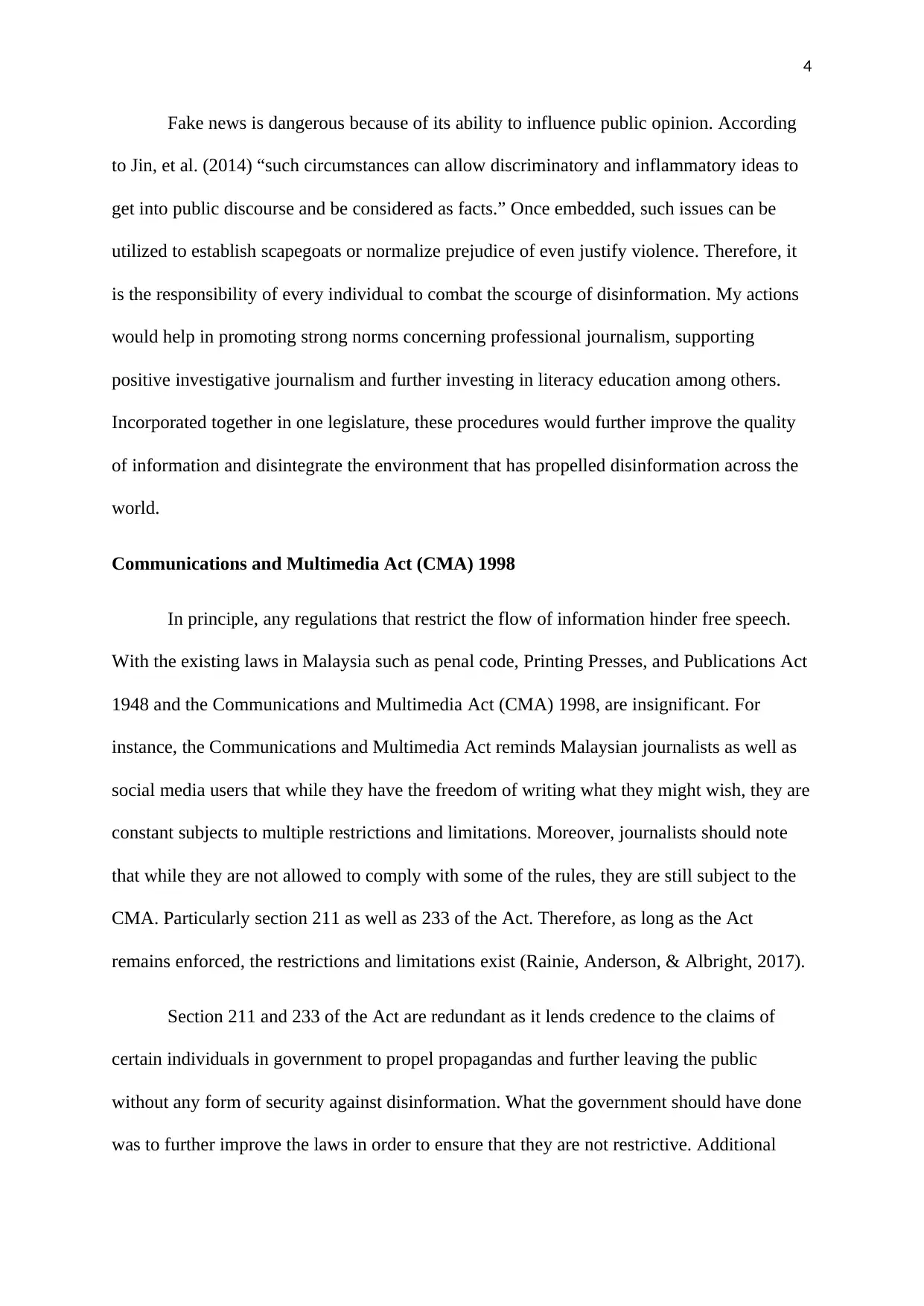
4
Fake news is dangerous because of its ability to influence public opinion. According
to Jin, et al. (2014) “such circumstances can allow discriminatory and inflammatory ideas to
get into public discourse and be considered as facts.” Once embedded, such issues can be
utilized to establish scapegoats or normalize prejudice of even justify violence. Therefore, it
is the responsibility of every individual to combat the scourge of disinformation. My actions
would help in promoting strong norms concerning professional journalism, supporting
positive investigative journalism and further investing in literacy education among others.
Incorporated together in one legislature, these procedures would further improve the quality
of information and disintegrate the environment that has propelled disinformation across the
world.
Communications and Multimedia Act (CMA) 1998
In principle, any regulations that restrict the flow of information hinder free speech.
With the existing laws in Malaysia such as penal code, Printing Presses, and Publications Act
1948 and the Communications and Multimedia Act (CMA) 1998, are insignificant. For
instance, the Communications and Multimedia Act reminds Malaysian journalists as well as
social media users that while they have the freedom of writing what they might wish, they are
constant subjects to multiple restrictions and limitations. Moreover, journalists should note
that while they are not allowed to comply with some of the rules, they are still subject to the
CMA. Particularly section 211 as well as 233 of the Act. Therefore, as long as the Act
remains enforced, the restrictions and limitations exist (Rainie, Anderson, & Albright, 2017).
Section 211 and 233 of the Act are redundant as it lends credence to the claims of
certain individuals in government to propel propagandas and further leaving the public
without any form of security against disinformation. What the government should have done
was to further improve the laws in order to ensure that they are not restrictive. Additional
Fake news is dangerous because of its ability to influence public opinion. According
to Jin, et al. (2014) “such circumstances can allow discriminatory and inflammatory ideas to
get into public discourse and be considered as facts.” Once embedded, such issues can be
utilized to establish scapegoats or normalize prejudice of even justify violence. Therefore, it
is the responsibility of every individual to combat the scourge of disinformation. My actions
would help in promoting strong norms concerning professional journalism, supporting
positive investigative journalism and further investing in literacy education among others.
Incorporated together in one legislature, these procedures would further improve the quality
of information and disintegrate the environment that has propelled disinformation across the
world.
Communications and Multimedia Act (CMA) 1998
In principle, any regulations that restrict the flow of information hinder free speech.
With the existing laws in Malaysia such as penal code, Printing Presses, and Publications Act
1948 and the Communications and Multimedia Act (CMA) 1998, are insignificant. For
instance, the Communications and Multimedia Act reminds Malaysian journalists as well as
social media users that while they have the freedom of writing what they might wish, they are
constant subjects to multiple restrictions and limitations. Moreover, journalists should note
that while they are not allowed to comply with some of the rules, they are still subject to the
CMA. Particularly section 211 as well as 233 of the Act. Therefore, as long as the Act
remains enforced, the restrictions and limitations exist (Rainie, Anderson, & Albright, 2017).
Section 211 and 233 of the Act are redundant as it lends credence to the claims of
certain individuals in government to propel propagandas and further leaving the public
without any form of security against disinformation. What the government should have done
was to further improve the laws in order to ensure that they are not restrictive. Additional
Secure Best Marks with AI Grader
Need help grading? Try our AI Grader for instant feedback on your assignments.
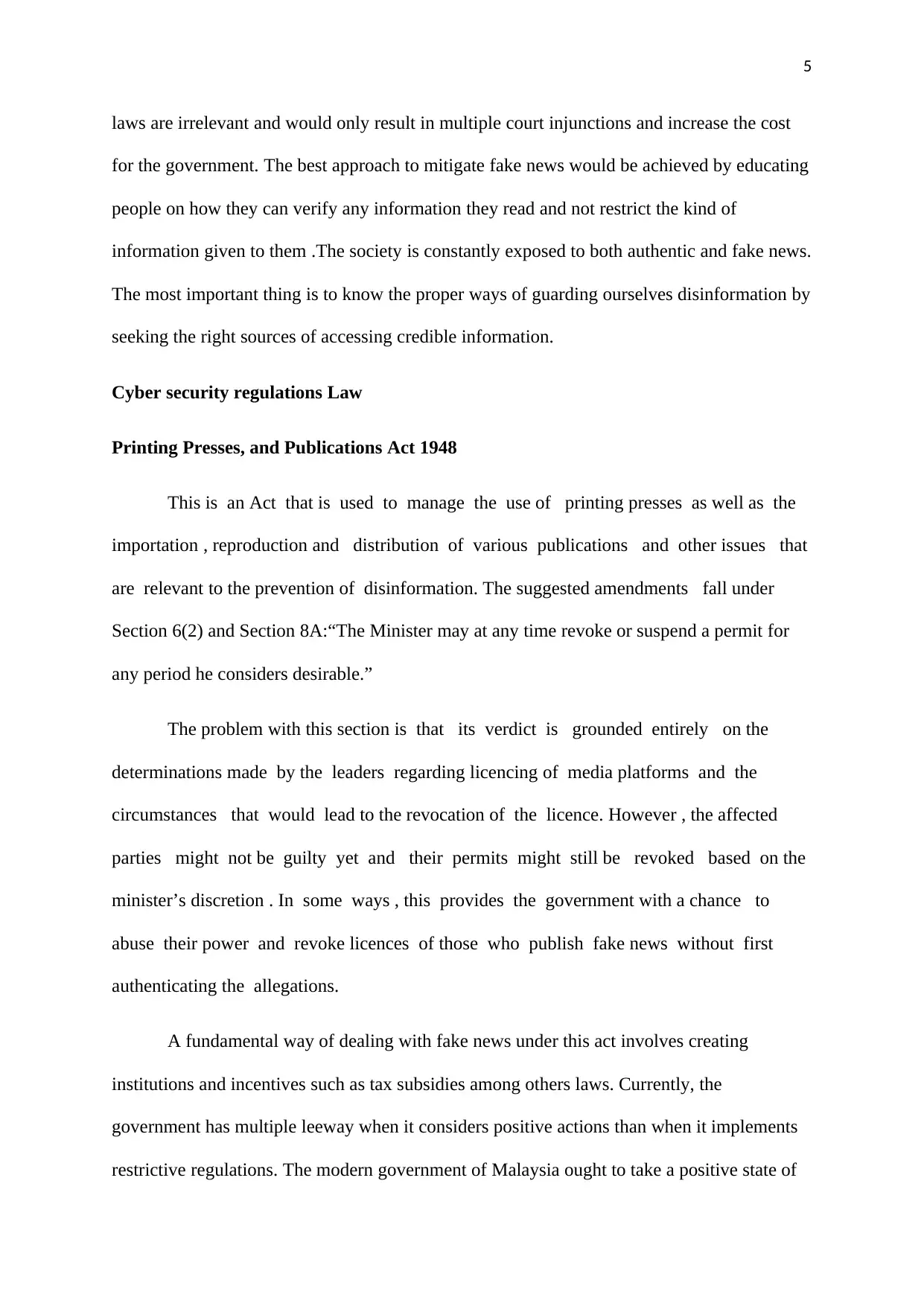
5
laws are irrelevant and would only result in multiple court injunctions and increase the cost
for the government. The best approach to mitigate fake news would be achieved by educating
people on how they can verify any information they read and not restrict the kind of
information given to them .The society is constantly exposed to both authentic and fake news.
The most important thing is to know the proper ways of guarding ourselves disinformation by
seeking the right sources of accessing credible information.
Cyber security regulations Law
Printing Presses, and Publications Act 1948
This is an Act that is used to manage the use of printing presses as well as the
importation , reproduction and distribution of various publications and other issues that
are relevant to the prevention of disinformation. The suggested amendments fall under
Section 6(2) and Section 8A:“The Minister may at any time revoke or suspend a permit for
any period he considers desirable.”
The problem with this section is that its verdict is grounded entirely on the
determinations made by the leaders regarding licencing of media platforms and the
circumstances that would lead to the revocation of the licence. However , the affected
parties might not be guilty yet and their permits might still be revoked based on the
minister’s discretion . In some ways , this provides the government with a chance to
abuse their power and revoke licences of those who publish fake news without first
authenticating the allegations.
A fundamental way of dealing with fake news under this act involves creating
institutions and incentives such as tax subsidies among others laws. Currently, the
government has multiple leeway when it considers positive actions than when it implements
restrictive regulations. The modern government of Malaysia ought to take a positive state of
laws are irrelevant and would only result in multiple court injunctions and increase the cost
for the government. The best approach to mitigate fake news would be achieved by educating
people on how they can verify any information they read and not restrict the kind of
information given to them .The society is constantly exposed to both authentic and fake news.
The most important thing is to know the proper ways of guarding ourselves disinformation by
seeking the right sources of accessing credible information.
Cyber security regulations Law
Printing Presses, and Publications Act 1948
This is an Act that is used to manage the use of printing presses as well as the
importation , reproduction and distribution of various publications and other issues that
are relevant to the prevention of disinformation. The suggested amendments fall under
Section 6(2) and Section 8A:“The Minister may at any time revoke or suspend a permit for
any period he considers desirable.”
The problem with this section is that its verdict is grounded entirely on the
determinations made by the leaders regarding licencing of media platforms and the
circumstances that would lead to the revocation of the licence. However , the affected
parties might not be guilty yet and their permits might still be revoked based on the
minister’s discretion . In some ways , this provides the government with a chance to
abuse their power and revoke licences of those who publish fake news without first
authenticating the allegations.
A fundamental way of dealing with fake news under this act involves creating
institutions and incentives such as tax subsidies among others laws. Currently, the
government has multiple leeway when it considers positive actions than when it implements
restrictive regulations. The modern government of Malaysia ought to take a positive state of
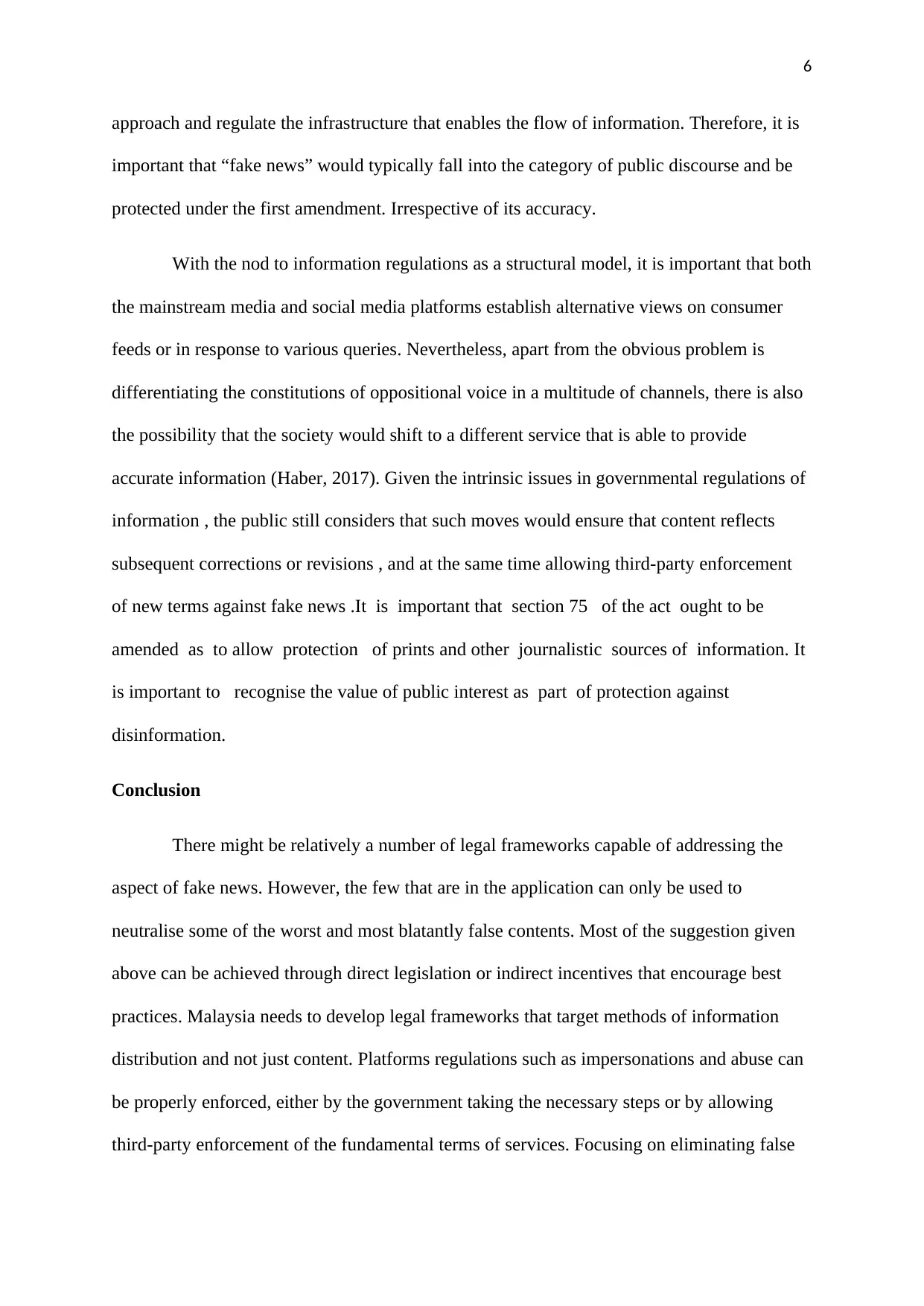
6
approach and regulate the infrastructure that enables the flow of information. Therefore, it is
important that “fake news” would typically fall into the category of public discourse and be
protected under the first amendment. Irrespective of its accuracy.
With the nod to information regulations as a structural model, it is important that both
the mainstream media and social media platforms establish alternative views on consumer
feeds or in response to various queries. Nevertheless, apart from the obvious problem is
differentiating the constitutions of oppositional voice in a multitude of channels, there is also
the possibility that the society would shift to a different service that is able to provide
accurate information (Haber, 2017). Given the intrinsic issues in governmental regulations of
information , the public still considers that such moves would ensure that content reflects
subsequent corrections or revisions , and at the same time allowing third-party enforcement
of new terms against fake news .It is important that section 75 of the act ought to be
amended as to allow protection of prints and other journalistic sources of information. It
is important to recognise the value of public interest as part of protection against
disinformation.
Conclusion
There might be relatively a number of legal frameworks capable of addressing the
aspect of fake news. However, the few that are in the application can only be used to
neutralise some of the worst and most blatantly false contents. Most of the suggestion given
above can be achieved through direct legislation or indirect incentives that encourage best
practices. Malaysia needs to develop legal frameworks that target methods of information
distribution and not just content. Platforms regulations such as impersonations and abuse can
be properly enforced, either by the government taking the necessary steps or by allowing
third-party enforcement of the fundamental terms of services. Focusing on eliminating false
approach and regulate the infrastructure that enables the flow of information. Therefore, it is
important that “fake news” would typically fall into the category of public discourse and be
protected under the first amendment. Irrespective of its accuracy.
With the nod to information regulations as a structural model, it is important that both
the mainstream media and social media platforms establish alternative views on consumer
feeds or in response to various queries. Nevertheless, apart from the obvious problem is
differentiating the constitutions of oppositional voice in a multitude of channels, there is also
the possibility that the society would shift to a different service that is able to provide
accurate information (Haber, 2017). Given the intrinsic issues in governmental regulations of
information , the public still considers that such moves would ensure that content reflects
subsequent corrections or revisions , and at the same time allowing third-party enforcement
of new terms against fake news .It is important that section 75 of the act ought to be
amended as to allow protection of prints and other journalistic sources of information. It
is important to recognise the value of public interest as part of protection against
disinformation.
Conclusion
There might be relatively a number of legal frameworks capable of addressing the
aspect of fake news. However, the few that are in the application can only be used to
neutralise some of the worst and most blatantly false contents. Most of the suggestion given
above can be achieved through direct legislation or indirect incentives that encourage best
practices. Malaysia needs to develop legal frameworks that target methods of information
distribution and not just content. Platforms regulations such as impersonations and abuse can
be properly enforced, either by the government taking the necessary steps or by allowing
third-party enforcement of the fundamental terms of services. Focusing on eliminating false
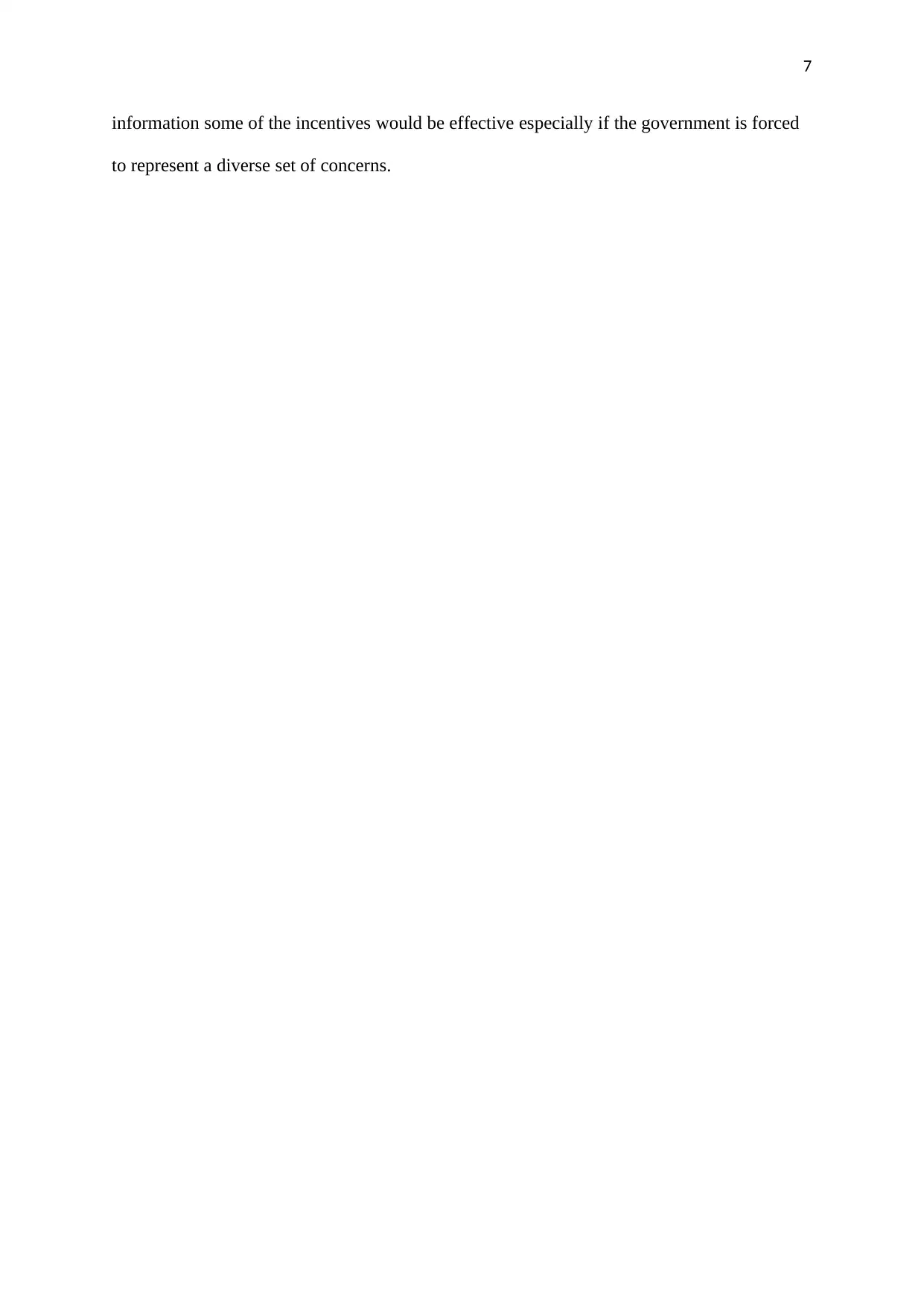
7
information some of the incentives would be effective especially if the government is forced
to represent a diverse set of concerns.
information some of the incentives would be effective especially if the government is forced
to represent a diverse set of concerns.
Paraphrase This Document
Need a fresh take? Get an instant paraphrase of this document with our AI Paraphraser
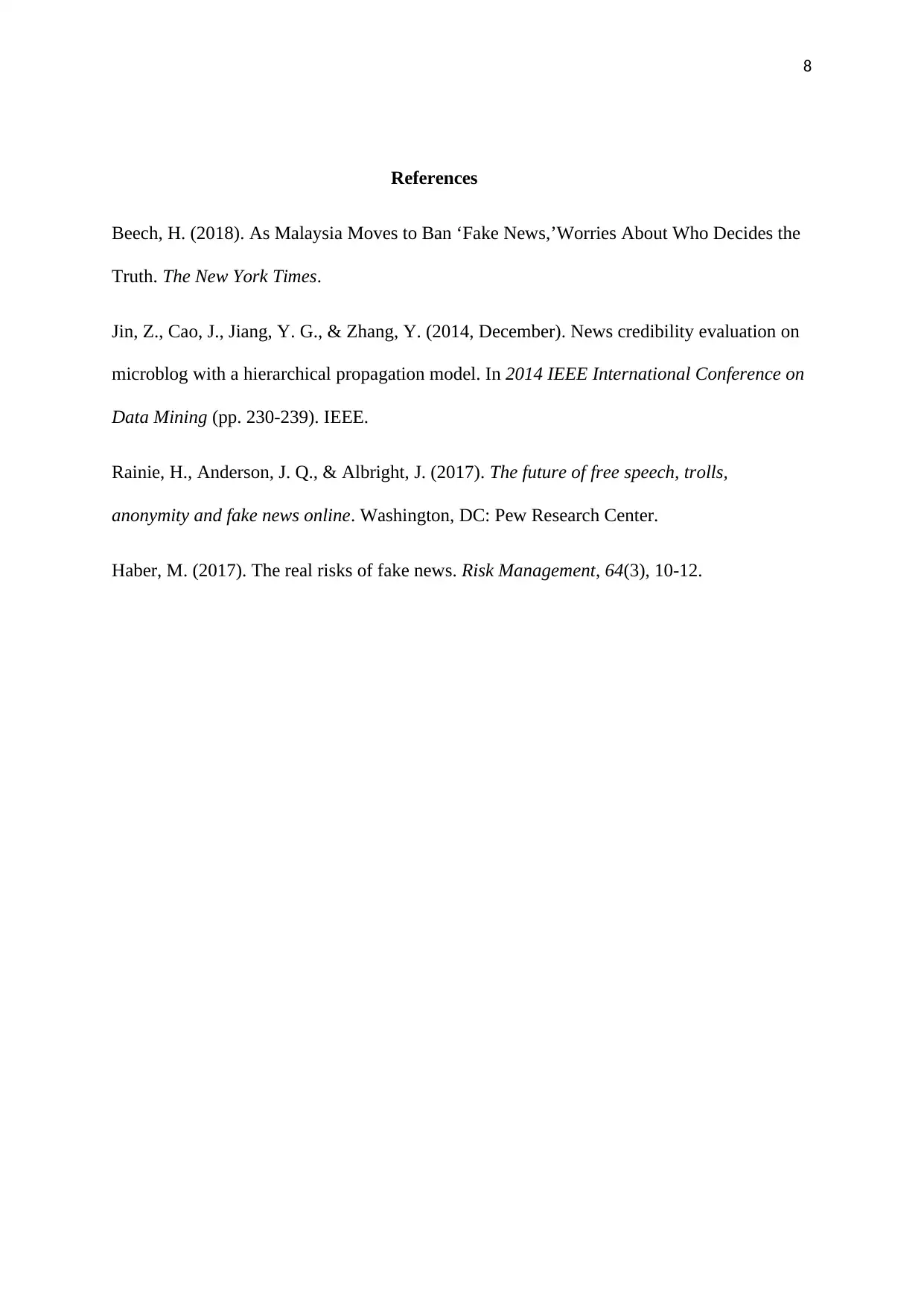
8
References
Beech, H. (2018). As Malaysia Moves to Ban ‘Fake News,’Worries About Who Decides the
Truth. The New York Times.
Jin, Z., Cao, J., Jiang, Y. G., & Zhang, Y. (2014, December). News credibility evaluation on
microblog with a hierarchical propagation model. In 2014 IEEE International Conference on
Data Mining (pp. 230-239). IEEE.
Rainie, H., Anderson, J. Q., & Albright, J. (2017). The future of free speech, trolls,
anonymity and fake news online. Washington, DC: Pew Research Center.
Haber, M. (2017). The real risks of fake news. Risk Management, 64(3), 10-12.
References
Beech, H. (2018). As Malaysia Moves to Ban ‘Fake News,’Worries About Who Decides the
Truth. The New York Times.
Jin, Z., Cao, J., Jiang, Y. G., & Zhang, Y. (2014, December). News credibility evaluation on
microblog with a hierarchical propagation model. In 2014 IEEE International Conference on
Data Mining (pp. 230-239). IEEE.
Rainie, H., Anderson, J. Q., & Albright, J. (2017). The future of free speech, trolls,
anonymity and fake news online. Washington, DC: Pew Research Center.
Haber, M. (2017). The real risks of fake news. Risk Management, 64(3), 10-12.
1 out of 8
Related Documents
Your All-in-One AI-Powered Toolkit for Academic Success.
+13062052269
info@desklib.com
Available 24*7 on WhatsApp / Email
![[object Object]](/_next/static/media/star-bottom.7253800d.svg)
Unlock your academic potential
© 2024 | Zucol Services PVT LTD | All rights reserved.





